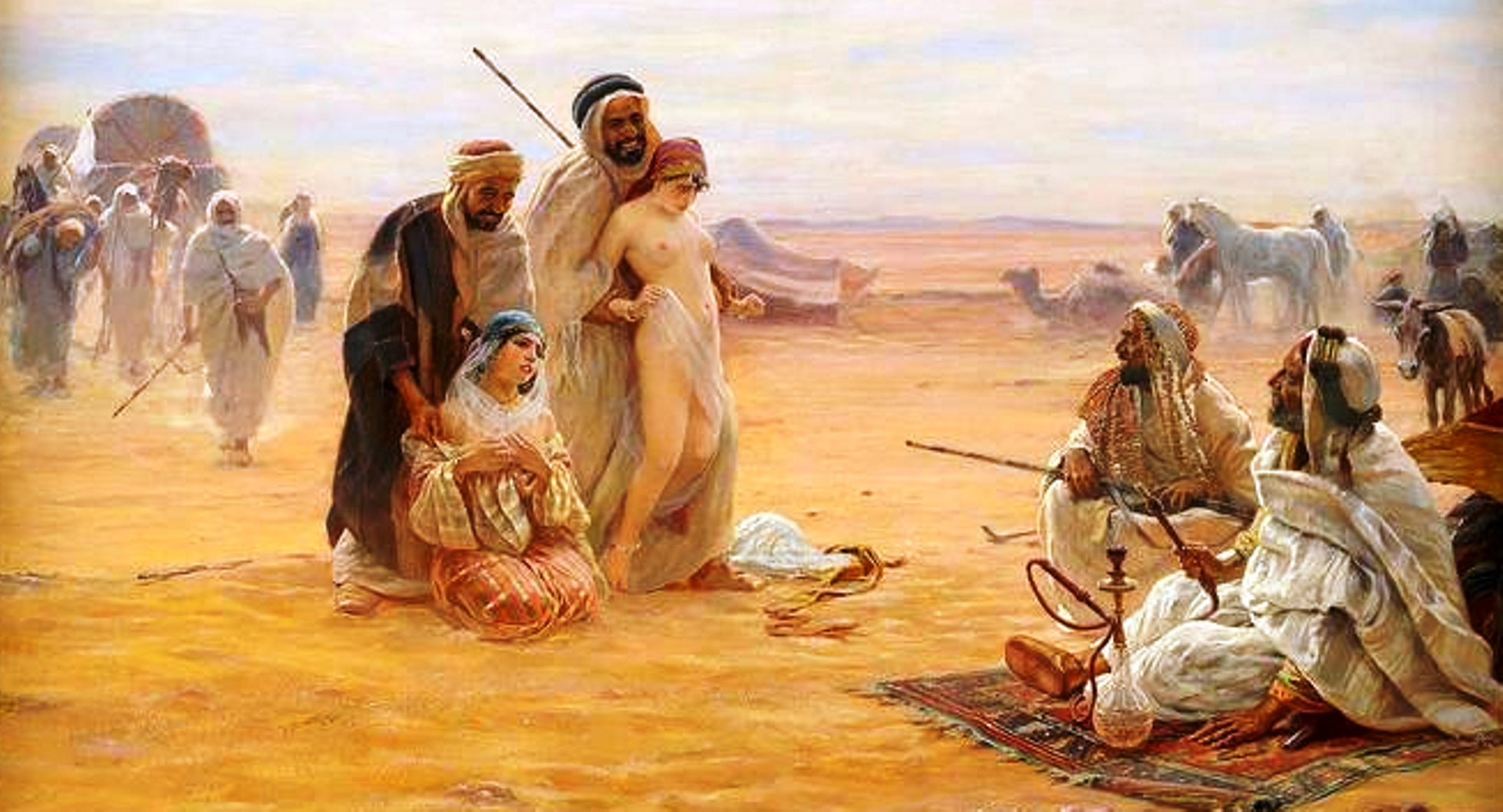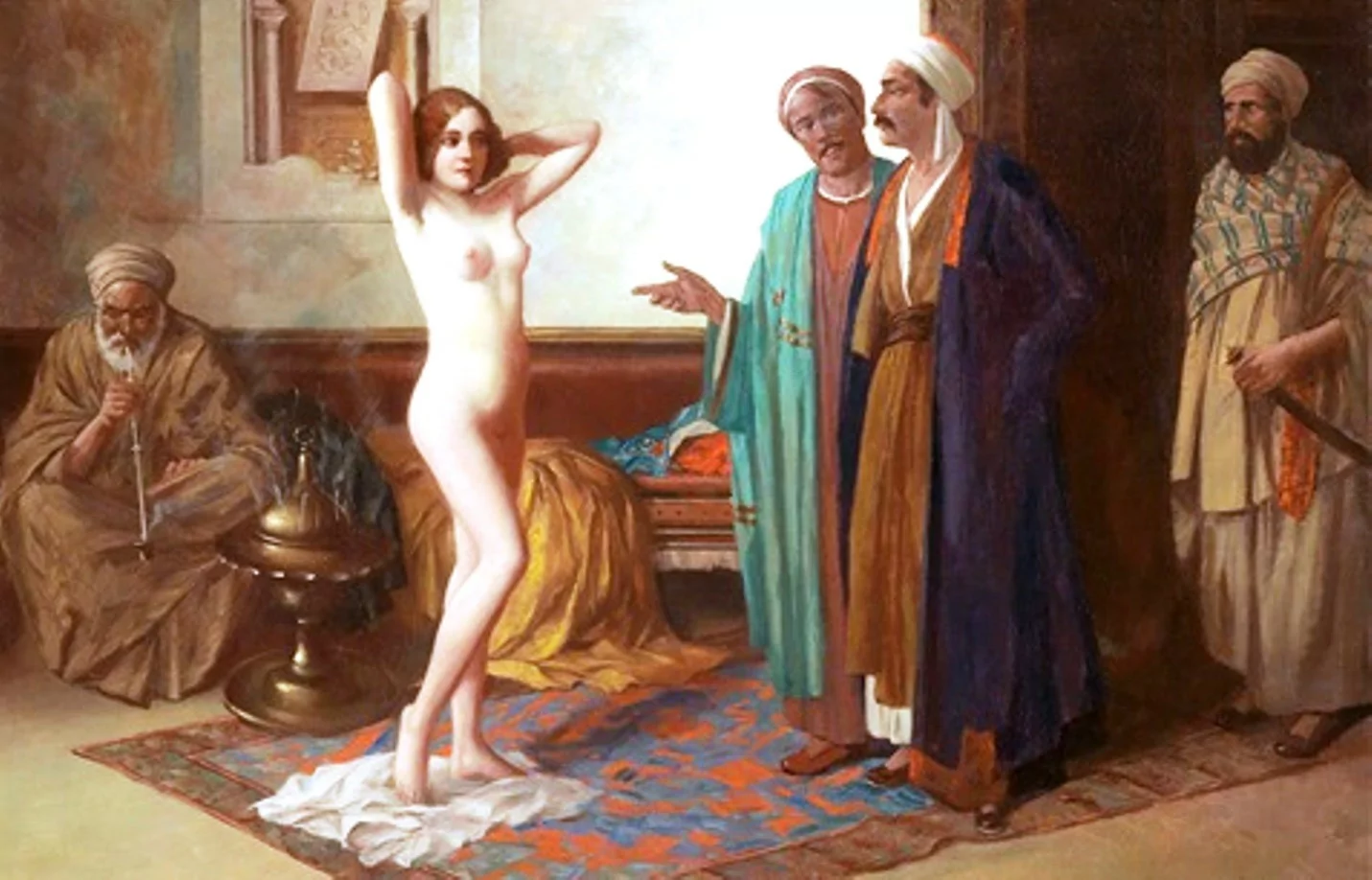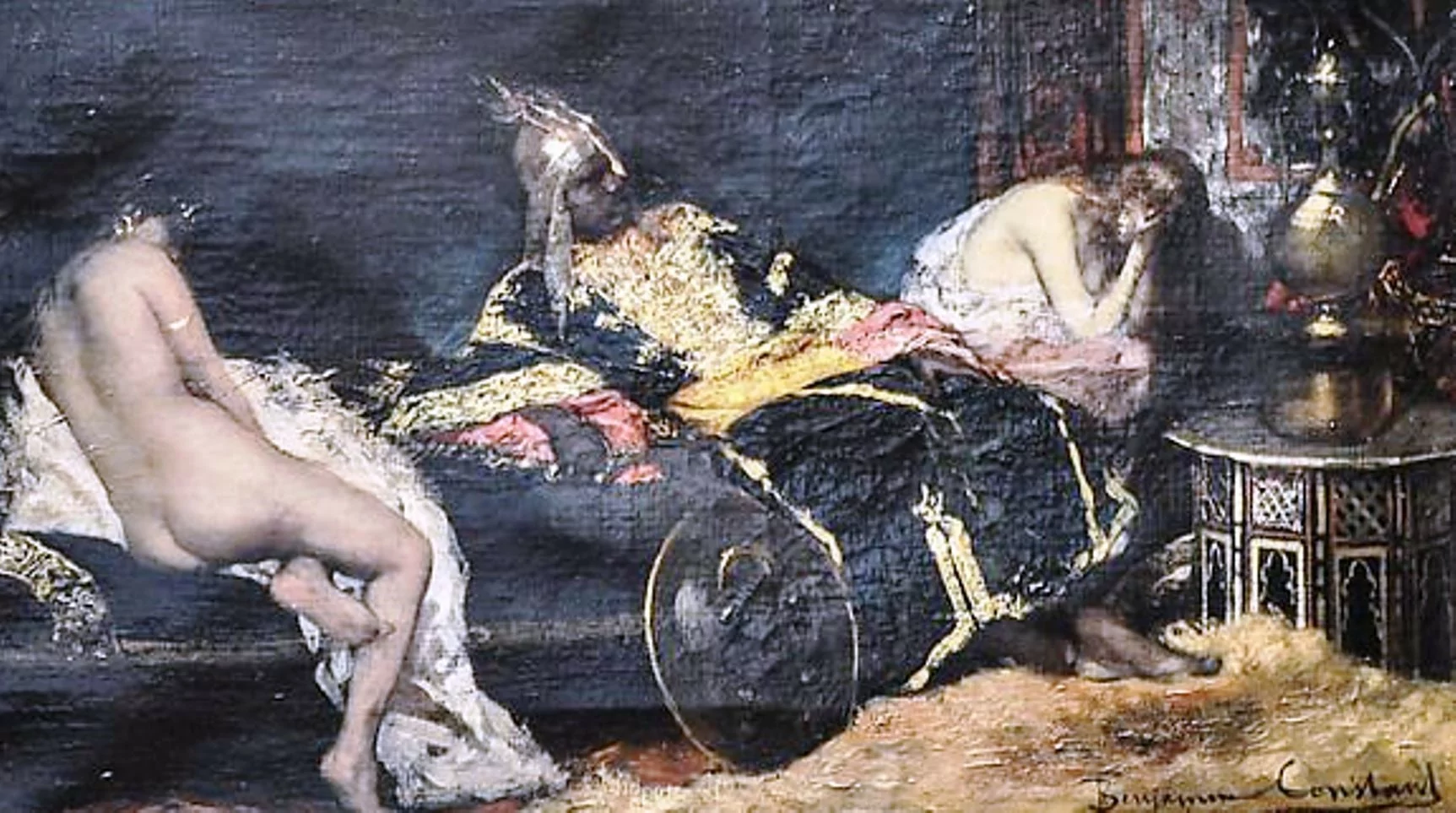
Raymond Ibrahim, author of Sword and Scimitar, is a Shillman Fellow at the David Horowitz Freedom Center.
Last year, a political party in Germany provoked controversy when it used the following painting in its election campaign to illustrate one of the reasons it was against immigration.

Painted in France in 1866 and titled “Slave Market,” the painting was described as “show[ing] a black, apparently Muslim slave trader displaying a naked young woman with much lighter skin to a group of men for examination,” probably in North Africa.
The Alternative for Germany party (AfD) put up several posters of this painting with the slogan, “So that Europe won’t become Eurabia.” Many on both sides of the Atlantic were “triggered” by this usage; even the American museum where the original painting is housed sent AfD a letter “insisting that they cease and desist in using this painting” (even though it is in the public domain).
Objectively speaking, the “Slave Market” painting in question portrays a reality that has played out countless times over the centuries: African, Asiatic, and Middle Eastern Muslims have long targeted European women—so much so as to have enslaved millions of them over the centuries (see Sword and Scimitar for copious documentation).
As it happens, there is something else—another medium besides writing—that documents this reality: countless more paintings than the one in question concerning the abduction, trafficking, and sexual enslavement of European women; altogether they further underscore the ubiquity and notoriety of this phenomenon. Indeed, this was such a well-known theme that many nineteenth and early twentieth century artists and painters specialized in it, often based on their own eye-witness accounts. (As one art gallery puts it, “Many … of the most important painters did travel [to the Muslim world] themselves, and what they painted was based on the sketches they had made while they were there…)
Below are just 20 such paintings (there are many more). Aside from noting the artist’s name, year of painting, and, where possible, title—information which is often difficult to ascertain—I’ve limited my remarks to important asides and clarifications, mostly in the first few paintings, leaving the rest to speak for themselves. They follow.

“The Bulgarian Martyresses,” by Konstantin Makovsky, 1877. It depicts events from a year earlier, when Ottoman irregular soldiers (the so-called bashi-bazouks or “crazy heads”) raped and massacred the Christian women of Bulgaria and their children. American journalist MacGahan, who reported from Bulgaria, wrote the following of this incident: “When a Mohammedan has killed a certain number of infidels he is sure of Paradise, no matter what his sins may be.…[T]he ordinary Mussulman takes the precept in broader acceptation, and counts women and children as well…. the Bashi-Bazouks, in order to swell the count, ripped open pregnant women, and killed the unborn infants.”

“The Abduction of a Herzegovinian Woman,” by Jaroslav Čermák, 1861. From the museum’s official description: “Disturbing and extremely evocative, it depicts a white, nude [and pregnant?] Christian woman being abducted from her village by the Ottoman mercenaries who have killed her husband and baby.”

“The Abduction,” by Eduard Ansen-Hofmann (1820-1904).

“The Slave Market,” by Otto Pilny, 1910.

“Abducted,” by Eduard Ansen-Hofmann (1820–1904).

“Namona,” by Henri Tanoux, 1883.

“The Bitter Draught of Slavery,” by Ernest Norman, 1885.

“A New Arrival,” by Giulio Rosati (1858–1917).

“The New Slave Girl,” by Eduard Ansen-Hofmann (1820-1904).

“Examining Slaves,” by Ettore Cercone, 1890.

“Slave Dealer,” by Otto Pilny, 1919.

“Slave Market,” by Eduard Ansen-Hofmann, 1900.

“Slave Trade Negotiations,” by Fabio Fabbi (1861-1946).
 “White Slavery in the East—Going to the Slave Market,” by Harper’s Weekly, April 1875.
“White Slavery in the East—Going to the Slave Market,” by Harper’s Weekly, April 1875.

“New Arrival,” by Eduard Ansen-Hofmann (1820-1904).

“The Serbian Concubine,” by Jean-Joseph Benjamin-Constant, 1876.

“Slave Market,” by Émile Jean-Horace Vernet, 1836.

“Slave Market,” by Jean-Leon Gerome, 1871.

“Harem Captive,” by Eisenhut Ferencz, 1903.

“Scene from the Harem,” by Fernand Cormon, 1877.


With all this information publicly available, how come Europeans and Americans are becoming willing hostages to Islamists?
And remaining so hateful towards Hindus who have faced such barbaric assaults for over 1200 hundred years?
And now hostile to Jews who just endured another such scene ?
There are bad and corrupt Muslims, just like there are bad and corrupt Christians, and people from all faiths.
This does NOT represent the belief and customs of 1.6 billion Muslims on this planet.
I can produce thousands of similar paintings, pictures and images of how Europeans and Americans treated their slaves even worse than how they treated their pets. These slaves were kept under sub-human conditions all their lives. The African slave women and girls were raped regularly by their owners.
They use these paintings of a couple of insidious people to show how bad Islam is. The actions of these people are NOT endorsed by Islam in any shape or form.
They claim that Mohammad SAW was a slave owner and abuser. They obviously ignore the truth that Mohammad SAW freed every slave that came under his ownership as war booty. Mohammad SAW did not even have one slave in his house when he died.
He [SAW] denied giving one slave to help her daughter, Fatima RA, who had asked for help for her daily chores.
Yeah, blah, blah, same tired excuses, etc, etc.
Muslims are still at it while other groups of people have stopped.
Yazidis + the women attacked, raped, murdered, abducted in Israel last year, for example.
Get your house in order, mate.
https://www.bbc.com/news/world-middle-east-30573385
As far as your comment about good and bad Christians and Muslims an observation that can be seen repeatedly, is that with Christians the more closely they adhere to God’s word in the Bible, the more good and godly their behavior, the further they moderate from the Bible the more bad and evil they are. With Islam the opposite is true, The closer one adheres to the teachings of Mohammad in the Quran, the more radical, evil and bad the Muslim is, The more moderate and further the Muslim is towards the Quran is, the more Good they are. However as to how “good” the moderate Muslims are as compared to the “Radical” evil Muslims, another observation that Ive repeatedly noticed is that when the Radical evil Muslims commit Satanic evil terrorist acts like September 11, 2001, the Mainstream media showed hundreds of thousands of so called “moderate “ Muslims hysterically celebrating In support of the Radicals in the streets in many of the Islamic countries! If the moderates are so good and so vast why are they not outraged that the Evil Radical Muslims are giving Islam a bad name? Why are they celebrating? Where are the so called vast majority of moderate “good” Muslims protesting the Radicals evil Muslim’s behavior? It would appear that a moderate Muslim is just a Radical Muslim that hasn’t hatched yet.
“It’s obligatory to follow the Sunnah of the Messenger of God and disbelieve in one who denies it.”
HER NAME WAS AISHA AND SHE WAS A VICTIM OF THIGHING = MUFA’KHATHAT
Literally translated, it means “placing between the thighs”
IMAGINE!
Imagine a 50 year old Arab stripping a 6 year old child naked and putting his “willie” between her thighs and wanking himself off; squirting his cum all over the child’s naked body!
IMAGINE!
Imagine this now 53 year old Arab having full, penetrative sexual intercourse with the 9 year old child and shooting his “load” of cum into her small vagina, shouting, “Allah Akbar”!
IMAGINE!
Allah says in the Quran:
(Sura 33:21).
You have indeed in the Messenger of Allah an excellent example for him who hopes in Allah and the Last Day, and who remembers Allah much.
In this verse Allah instructs Muslims to follow Prophet Muhammad who was an embodiment of the great values and manners of the Quran. He gave the best example for mankind in human history. Many Muslim writers bear witness that Prophet Muhammad is the greatest man in human history.
Sura 68:05
And thou dost, surely, possess sublime moral excellencies.